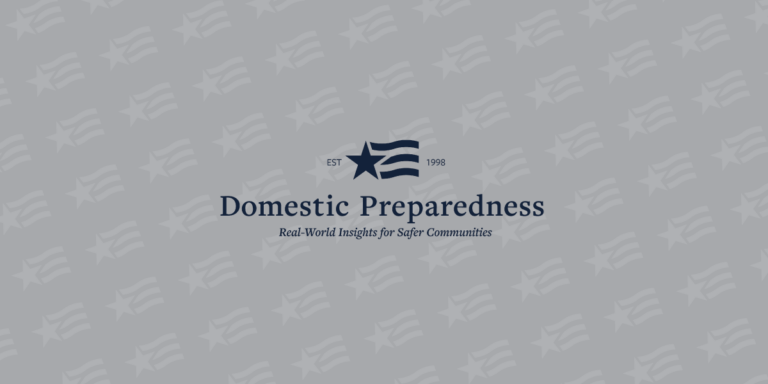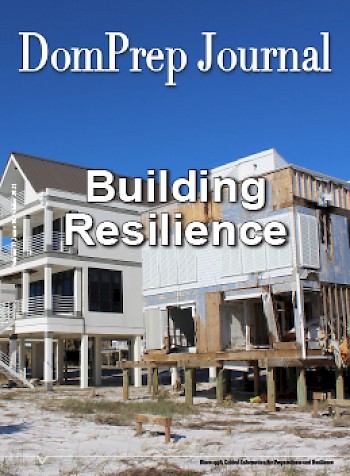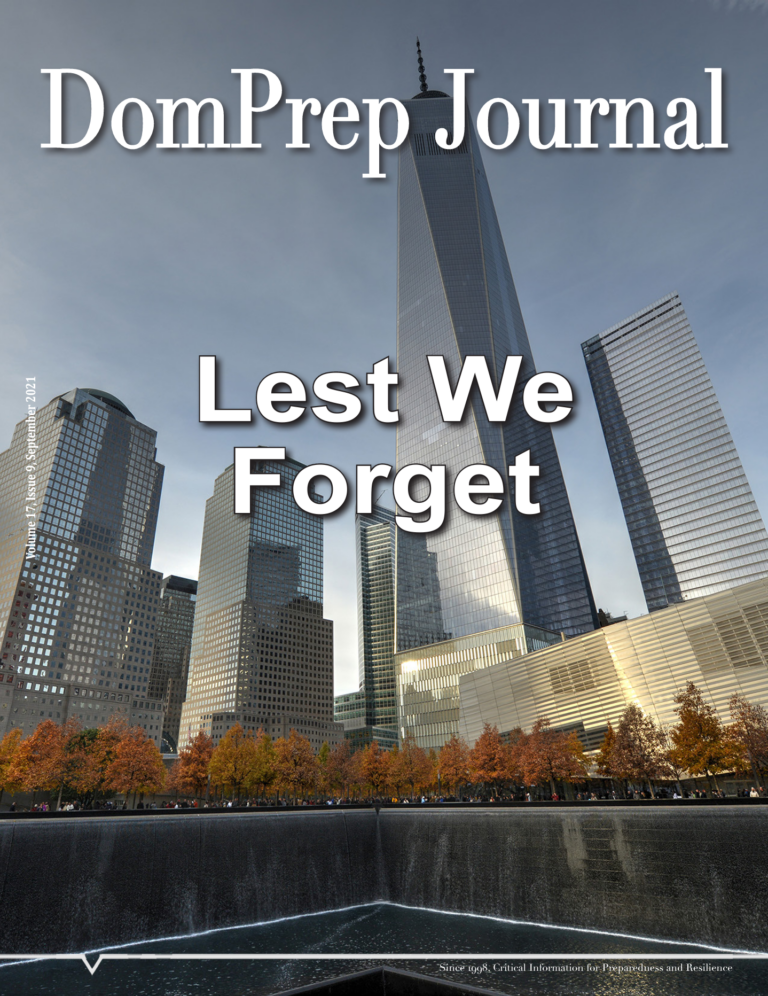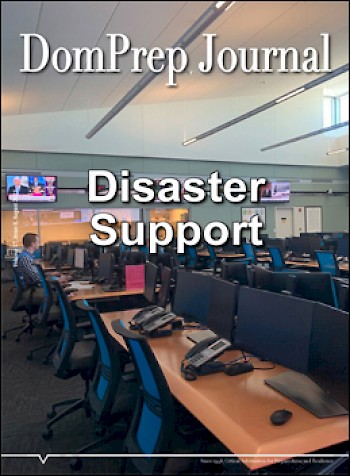
Author Archive

As climate change increases disaster risks across the country, emergency managers and government officials are beginning to implement strategies to build community resilience. FEMA Resources for Climate Resilience provides a roadmap of Federal Emergency Management Agency (FEMA) programs and initiatives that advance community climate resilience. FEMA Resources for Climate Resilience

2021 NATIONAL EMERGENCY MEDICAL SERVICES EDUCATION STANDARDS
Domestic Preparedness
December 6, 2021
The standards outline the critical topics to be covered in the initial education of EMS clinicians based on the latest version of the National EMS Scope of Practice Model, as well as recent research and best practices. The high-level document defines the competencies, clinical behaviors and judgments required of EMS

November 2021
Domestic Preparedness
November 24, 2021
Featured in this issue: Safety: Protecting Communities From Dangers & Risks, By Catherine L. Feinman; The Dangers of Not Protecting the “3Ps” During Events, By Kole (KC) Campbell; Cassandra’s Curse: Disasters Revisited, By Rodney Andreasen; Another Opportunity to Prepare for Quarantines, By Robert C. Hutchinson; Human-Machine Teaming: A Vision of

Climate Change and International Responses Increasing Challenges to US National Security Through 2040
Domestic Preparedness
November 5, 2021
This National Intelligence Council has released a National Intelligence Estimate (NIE) in response to a Presidential tasking to assess the national security impacts of climate change. https://www.dni.gov/files/ODNI/documents/assessments/NIE_Climate_Change_and_National_Security.pdf

October 2021
Domestic Preparedness
October 27, 2021
Featured in this issue: Building Resilience Into the Planning Process, By Catherine L. Feinman; Afghanistan – A Haven for Violent Extremism, By Richard Schoeberl, Anthony (Tony) Mottola & Anthony L. Clark; “Moneyball” for the Wildland Fire System, By Matthew P. Thompson & Erin J. Belval; It Is Time to Adopt

Saving Sisyphus: Advanced Biodetection for the 21st Century
Domestic Preparedness
October 22, 2021
The Bipartisan Commission on BioDefense released a new report on the National BioWatch system which details specific actions that must be taken to make the system effective. BioWatch was established in 2003 as a national biodetection system but has never been able to consistently demonstrate its operational capability in the field. The system

September 2021
Domestic Preparedness
September 29, 2021
Featured in this issue: Lest We Forget!, By Martin (Marty) Masiuk; September 11 – Remembrance & Recovery, By Anthony S. Mangeri; Never Forget: Focusing Events & Opportunity for Change, By Nim Kidd; Domestic Preparedness – Prepared for What?, By Rob Schnepp; Security Lessons Learned – Part 1, Boston Marathon Bombings,

CISA Can Improve Efforts to Ensure Dam Security and Resilience
Domestic Preparedness
September 19, 2021
Nationwide, there are more than 91,000 dams, levees, and other water retention structures protecting homes and businesses, delivering electricity, and providing recreation and transportation. In 2018, the Cybersecurity & Infrastructure Security Agency (CISA) became the newly formed Department of Homeland Security component responsible for Dams Sector security and resilience. This report makes

Preliminary Damage Assessment Guide
Domestic Preparedness
September 13, 2021
The Preliminary Damage Assessment Guide (PDA Guide) — a standard framework for how emergency management officials conduct preliminary damage assessments (PDAs) following a disaster—will be effective starting 1 October 2021. https://www.fema.gov/sites/default/files/documents/fema_2021-pda-guide.pdf

August 2021
Domestic Preparedness
August 25, 2021
Featured in this issue: Different Sides of Disaster Support, By Catherine L. Feinman; Emergency Management Projects in a Quasi-Pandemic World, By Sarah Keally; Building Codes Support Disaster Preparedness & Resilience, By Karl Fippinger; Psychological Effects of COVID-19 on Frontline Workers, By Hannah Bennett; COVID-19: Impact on Financial Fraud, By Michael
Follow Us
Get Instant Access
Subscribe today to Domestic Preparedness and get real-world insights for safer communities.
ARchives
Article Out Loud – Triage Strategies for Hazardous Materials Mass-Casualty Incidents
June 21, 2023
To increase victim survivability, this 2006 article describes how the RPMs (respiratory rate, pulse, and motor functions) can be used to START (Simple Triage And Rapid Treatment) processing victims.
Article Out Loud-THE MOST DANGEROUS EXISTENTIAL THREAT: ILLEGAL DRUGS
June 14, 2023
CDC reported that U.S. drug overdose deaths more than doubled between 2015 and 2021. This 2012 article outlined three major hurdles that will continue contributing to this increase until they are addressed.
Article Out Loud – Swatting: Combatting a Lethal and Expensive Prank
June 14, 2023
Swatting is making prank calls to bring armed responders to a specific location, usually a SWAT team. As such, responders need to be aware of this challenge and develop policies and procedures locally to address these calls.
Article Out Loud-NARCAN: THE SPRAY THAT SAVES
June 14, 2023
A pharmacist and member of a Disaster Medical Assistance Team shares his personal account of the challenges his team overcame when responding to Hurricane Katrina in this 2005 article. Listen on
Article Out Loud – After the Storm: A Flood of Compassion Healing the Wounded, in the City That Care Forgot
June 7, 2023
A pharmacist and member of a Disaster Medical Assistance Team share his personal account of the challenges his team overcame when responding to Hurricane Katrina in this 2005 article.
Article Out Loud – Service Animal Awareness in Disaster Response
June 7, 2023
Service animals are trained to perform specific daily tasks, which are often still required when responders are assisting during a hurricane, mass casualty event, or another emergency. As such, emergency planning efforts should include service animals to ensure responders can identify the animals’ critical roles, acknowledge their specialized training, and
Article Out Loud – Food and Agriculture Sector Perspectives
June 7, 2023
The Food and Agriculture Sector is one of 16 sectors identified as critical infrastructure under the Cybersecurity & Infrastructure Security Agency. Domestic Preparedness invited subject matter experts to answer important questions about this sector and how the sector and its interdependencies can affect any community.
Article Out Loud – Helping First Responders & The Public Bring Home Missing Kids
May 24, 2023
An existential danger is the exploitation of children. As the threat landscape evolves, first responders have a paramount role to play in protecting these vulnerable populations and maintaining a resilient homeland security enterprise.
Article Out Loud – CBRN Response Capabilities and Identified Gaps
May 24, 2023
Despite advancements in field identification and classification of substances with advanced instrumentation and tools, there is still a response gap regarding the proper decontamination of instruments and the people who use them.
Article Out Loud – A Healthcare Coalition’s Support for Evacuating a Facility
May 23, 2023
Learn how the National Capital Region took a giant step forward with the formation of a coalition partnership to cope with evacuations during catastrophic emergencies in this 2012 article.
Follow Us
Get Instant Access
Subscribe today to Domestic Preparedness and get real-world insights for safer communities.


